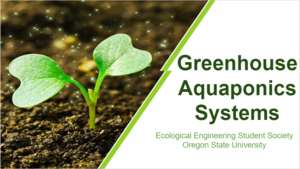
Over the last 5 years, members of the Ecological Engineering Student Society have been working on two on-campus aquaponics systems. Aquaponics is an agricultural technique that combines aquaculture with hydroponics to produce a self-sustaining ecosystem for both plant and fish growth. The EESS was granted access to greenhouse space in Weniger Hall, where we have been developing two small greenhouse aquaponics prototypes. Vegetable crops like kale and lettuce are grown in beds containing expanded clay pebble substrate, which are fed by water pumped from fish tanks (which are home to multiple goldfish). The water pumped from these fish tanks contains organic matter and nitrogenous fish waste. The suspended solids in the water are mechanically separated and used as soil fertilizer elsewhere. The resulting water is then pumped though the substrate beds, where nitrifying bacteria convert the remaining aqueous nutrients into plant available nitrates. Once the plants and beneficial bacteria have had their fill of nutrient, the now clean water then trickles back into the fish tanks to restart the cycle. From the two systems we have successfully grown edible vegetables for student consumption and sustained fish life. The next steps are to optimize the system to produce regular vegetable yields and to grow and harvest consumable fish such as perch or tilapia.
Some of the greatest challenges associated with traditional agriculture are the environmental impacts. Among one of the most important to consider are the effects of fertilizer. Artificial fertilizers often wash way though disturbed soil, and into local watersheds. This influx of nutrients can cause excessive algae blooms, which then consume oxygen and create anoxic dead zones. Another grave consequence of traditional agriculture is the habitat loss, and soil destruction required to expand fields for crops.
In our aquaponics systems we have created above-ground, symbiotic, closed-loop environments where all nutrients are produced and consumed in an equilibrium. The only two inputs in our systems are sunlight and water. From our two systems we have successfully grown edible vegetables for student consumption and have sustained fish life for multiple years. In broader applications, aquaponics can be used to farm both fish and vegetables.
Aquaponics systems are easily oriented in horizontal or vertical configurations. In our vertical system, we can grow more plants per square foot than in a standard horizontal garden plot. Where traditional farming might necessitate the burning or cutting of trees to make room for more crops, an aquaponics system would simply be built taller to achieve the same result.
Ecological engineers strive to balance society and nature together- They find eco-friendly answers to traditional systematic problems. We are living in a world where it is of the upmost importance to look for new answers to The agricultural industry today is one that is destructive, causes heavy pollution, and ultimately unsustainable in a world with increasing environmental concerns. Aquaponics is an innovative and environmentally sustainable technique that has had success in our greenhouses. It embodies our goals as the Ecological Engineering Student Society, and holds great promise for a sustainable future in agriculture.
